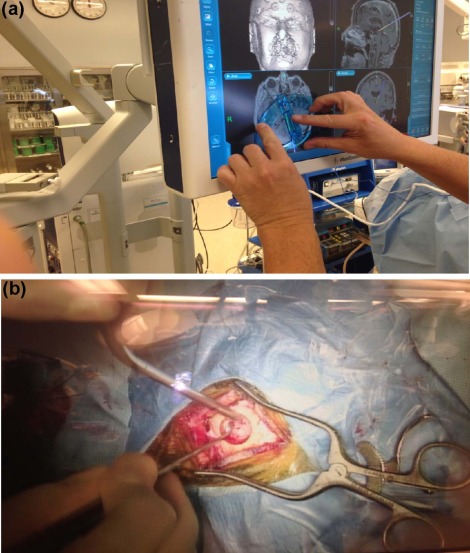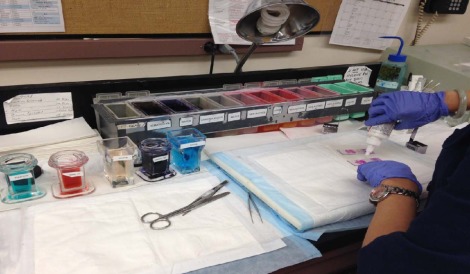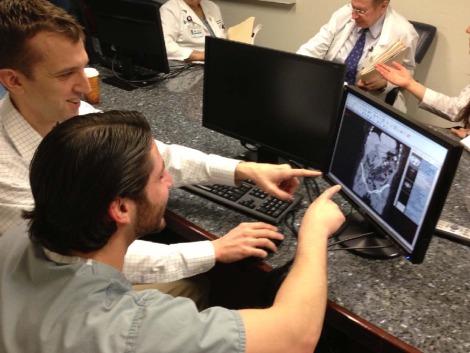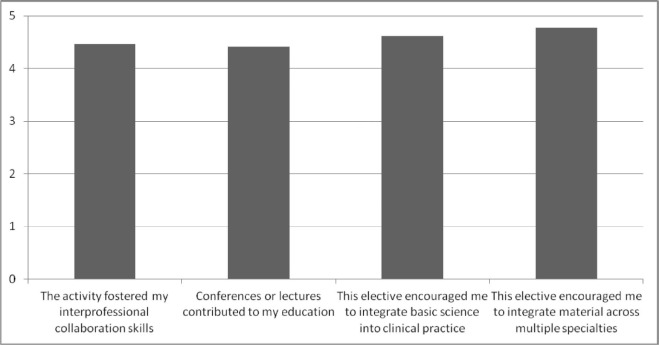Traditionally, the radiology elective has been designed to teach medical students the fundamentals of radiologic interpretation. When questioned, many students state that they want to take a radiology elective so they can “interpret images.” For the students on radiology, rotation/elective education was often passive, consisting of didactic conferences and observational shadowing of radiologists as they interpreted images. Students had only a superficial appreciation of how radiologists interacted with clinical services, multidisciplinary teams, and pathology. There was very little emphasis on imaging appropriateness or the most efficient and effective imaging for various clinical problems. With the expansion of numerous imaging modalities and the emphasis on patient-centered care, including imaging safety and dose reduction, it is important to change the focus of radiology education from interpretation to the optimal integration of imaging into clinical medicine.
Radiology-pathology (rad path) electives were created at Allegheny General Hospital and the Medical University of South Carolina as a new option to provide a high-quality advanced elective for fourth-year medical students. These electives enable students to correlate radiologic images with gross and microscopic pathology specimens, thus increasing their knowledge and understanding of both. The rad path elective combines aspects of surgery, radiology, and pathology and requires students to be active learners. The implementation of this elective is an exciting work in progress that has been evolving over the past 2 and 4 years at Medical University of South Carolina and Allegheny General Hospital, respectively. We will discuss the historical basis for the elective, the advantages and challenges of having such an integrated course, and some different strategies for creating a rad path elective.
Introduction
Radiology and pathology can be introduced into the radiology curriculum in a variety of ways. A study by Poot et al found that 25% of schools require radiology as a stand-alone required clerkship, while 6% of schools require pathology . A recent trend in radiology medical student education is to integrate radiology throughout the curriculum. Students who do not have a required radiology clerkship may get radiology education incorporated into preclinical coursework and the required third-year clerkships taught by radiologists and/or clinicians. A study by Straus et al found that the biggest change that radiology chairs and medical student deans would like to see in radiology medical student education was to increase the vertical curricular integration .
How are we doing with this vertical curricular integration? While it is too early to do an outcomes study, an unpublished survey by Hartman et al attempted, in part, to answer this question by asking fourth-year medical students how often they had followed a patient from imaging to surgery and ultimately, to the final pathologic diagnosis. Only 36% of students had followed a patient completely through this three-part process.
Historically, radiologic-pathologic correlation has been an Accreditation Council for Graduate Medical Education requirement of diagnostic radiology residency training. United States radiology residents have the opportunity to attend a 4-week rad path correlation course at the American Institute for Radiologic Pathology (AIRP). Residents submit a case that has a combination of radiologic images, gross surgical images, and microscopic images with pathologic confirmation . The case requirement of AIRP can serve as a model for the medical student experience.
There are different methods of including radiologic-pathologic correlation in the undergraduate medical curriculum. Jafri et al described a student-facilitated rad path correlation conference that was held as part of the radiology departmental conference . We expanded on this idea by creating a standalone elective that would allow students to prospectively follow multiple patients across the radiologic evaluation, surgical procedure, and pathologic diagnosis, thereby reinforcing the importance of basic science knowledge and interdisciplinary teams to clinical medicine. With the cooperation of the radiology, surgery, and pathology departments, we developed a 4-week elective.
Get Radiology Tree app to read full this article<
Table 1
Rad Path Learning Topics
Get Radiology Tree app to read full this article<
Get Radiology Tree app to read full this article<
Get Radiology Tree app to read full this article<
Get Radiology Tree app to read full this article<
Get Radiology Tree app to read full this article<
Get Radiology Tree app to read full this article<
BIRADS, breast imaging reporting and data system; FNA, fine needle aspirate; GU, genituourinary; RCC, renal cell carcinoma.
Get Radiology Tree app to read full this article<
Get Radiology Tree app to read full this article<
Table 2
Recent Case Log
2 Whipple Procedures for pancreatic cancer 2 Needle localizations with lumpectomies 1 Craniotomy for a Masson’s tumor 1 Thoracotomy for lung CA 1 Cystoprostacetomy for invasive bladder CA 1 Robot-assisted sigmoid colon CA resection 1 Ovarian CA debulking 15 Image-guided biopsies (breast MRI, thyroid, renal, lung, liver)
CA, cancer; MRI, magnetic resonance imaging.
Get Radiology Tree app to read full this article<
Get Radiology Tree app to read full this article<
Table 3
List of Multidisciplinary Conferences
General tumor board Gynecologic rad path tumor board Breast rad path tumor board Pancreatic conference Chest conference Foregut/Esophageal conference Endocrine conference Neuro rad path conference
Get Radiology Tree app to read full this article<
Get Radiology Tree app to read full this article<
Get Radiology Tree app to read full this article<
Get Radiology Tree app to read full this article<
Get Radiology Tree app to read full this article<
Get Radiology Tree app to read full this article<
Get Radiology Tree app to read full this article<
Get Radiology Tree app to read full this article<
Discussion
Get Radiology Tree app to read full this article<
Get Radiology Tree app to read full this article<
Get Radiology Tree app to read full this article<
Get Radiology Tree app to read full this article<
Get Radiology Tree app to read full this article<
Get Radiology Tree app to read full this article<
References
1. Poot J.D., Hartman M.S., Daffner R.H.: Understanding the US medical school requirements and medical students’ attitudes about radiology rotations. Acad Radiol 2012; 19: pp. 369-373.
2. Straus C.M., Webb E.M., Kondo K.L., et. al.: Medical student radiology education: summary and recommendations from a national survey of medical school and radiology department leadership. J Am Coll Radiol 2014; 11: pp. 606-610.
3. Murphy M.D., Madewell J.E., Olmsted W.W., et. al.: A history of radiologic pathology correlation at the Armed Forces Institute of Pathology and its evolution into the American Institute for Radiologic Pathology. Radiology 2012; 262: pp. 623-634.
4. Jafri N.F., Nadgir R., Slanetz P.J.: Student-facilitated radiology-pathology correlation conferences: an experiential educational tool to teach multidisciplinary patient care. J Am Coll Radiol 2010; 7: pp. 512-516.
5. Collins J.: Education techniques for lifelong learning lifelong learning in the 21st century and beyond. Radiographics 2009; 29: pp. 613-622.



